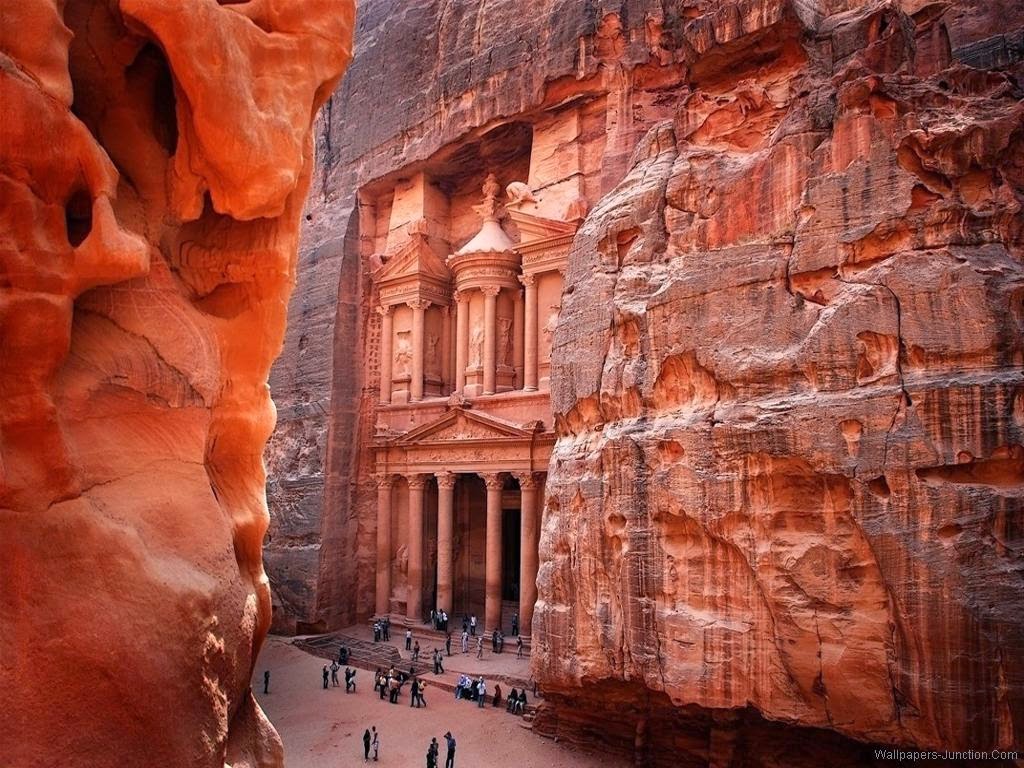WHERE IS
JORDAN?
Jordan is located in the Middle East and borders
Syria, Saudi Arabia, the Red Sea, Palestine, Israel, and Iraq. Covering some
89,342 sq.km., it is located at 31 00 N, 36 00 E.
JORDAN'S HISTORY
Jordan is a land steeped in history. It has been
home to some of mankind's earliest settlements and villages, and relics of many
of the worlds great civilizations can still be seen today.
As the crossroads of the Middle East, the lands of Jordan and Palestine have served as a strategic nexus connecting Asia, Africa and Europe. Thus, since the dawn of civilization, Jordan's geography has given it an important role to play as a conduit for trade and communications, connecting east and west, north and south. Jordan continues to play this role today.
Take an interactive tour through Jordan's history starting from the Paleolithic Era, right up to modern day with our Interactive Historical Timeline .
As the crossroads of the Middle East, the lands of Jordan and Palestine have served as a strategic nexus connecting Asia, Africa and Europe. Thus, since the dawn of civilization, Jordan's geography has given it an important role to play as a conduit for trade and communications, connecting east and west, north and south. Jordan continues to play this role today.
Take an interactive tour through Jordan's history starting from the Paleolithic Era, right up to modern day with our Interactive Historical Timeline .
10 Top Tourist Attractions in Jordan :
The Treasury is the most celebrated monument at ancient Petra – a magnificent site that was voted as being one of the New Seven Wonders of the World. Carved in the 1st century B.C. for an important Nabataean king, the enormous façade draws its artistic influences from ancient Alexandria and is breathtaking in its scale and grandeur. Famously called the ‘rose-red city half as old as time’, Petra’s extraordinary coloured rocks, grand tombs, and elegant carved façades are among the world’s most impressive archaeological treasures.
2- Roman City of Jerash
3- Red Desert of Wadi Rum
“Vast, echoing and God-like” was how T.E Lawrence (of Arabia) described the dramatic desert valley of Rum which offers some of the most dramatic scenery in Arabia. Rum is a timeless and starkly beautiful place where massive, uniquely shaped mountains rise out of the red desert. A visit to the valley, which is best explored on camel back or by 4WD jeep, casts one back to a time when vast caravans of merchants plied the desert carrying spices and exotic goods from the Indies to the Mediterranean. Rum is a truly unforgettable and authentically Arabian experience.
4- The Monastery (Ed Deir) at Petra
The Monastery (Ed Deir in Arabic) is Petra’s largest monument and may have been dedicated to the Nabataean king Obodas 1 who reigned in the 1st century B.C. Best seen in the afternoon sunlight, the Monastery requires some effort to reach. Those who ascend the 800 steps to Obodas’s tomb will enjoy magnificent views of the surrounding mountains and be rewarded with the stunning spectacle of ancient Petra’s second most magnificent monument.
5- The Dead Sea
No one can sink in the Dead Sea’s saline waters which have a salt content ten times higher than the Mediterranean. Said to have been visited by Queen Cleopatra, the Dead Sea is the world’s oldest natural spa, and is situated at more than 360 metres below sea-level. The Dead Sea region offers luxury accommodation complete with extensive spas, and is an ideal place to spend a few days following your tour.
6- Castle of Kerak
The huge Crusader and Mamluk castle of Kerak with its awe-inspiring ring of walls and towers has been a fortress since Biblical times. The Crusaders took 20 years to fortify the site which became the seat of the Lord of Oultrejordain, one the most important fiefs of the Crusader Kingdom. In the late 12th century Kerak castle was attacked twice by the Arab leader Saladin. The film Kingdom of Heaven contains a fictional portrayal of the resulting siege.
7- Wadi Dana Biosphere Reserve
Jordan’s largest nature reserve covers 320 km2 of rugged and beautiful landscape along the face of the Jordan Rift Valley. The reserve features four different bio-geographical zones, and is home of more than 800 plant species and a wide variety of wildlife. This is an ideal place to get off the beaten track, follow the hiking trails, and experience the beauty and tranquillity of the Jordanian wilderness.
8- Red Sea Coral Reefs at Aqaba
Swimming; snorkelling; scuba-diving; water-sports; relaxing in the sunshine; and luxury accommodation are some of the attractions on offer at Aqaba, Jordan’s resort town on the Red Sea. The submarine world in the Gulf of Aqaba offers a kaleidoscope of brightly coloured corals, and multitude of exotic fish species. The off-shore reefs can be visited by boat excursions.
9- Qasr Amra and the Desert Castles
Located in the black basalt desert to the east of Amman, a visit to the isolated Desert Castles will take you off the beaten track into the wilderness and back to the beginning of the Islamic period of Jordanian history. Qasr Amra is the most important site in the region and has been awarded UNESCO World Heritage status, while Qasr Azraq offers a Lawrence of Arabia connection, and Qasr Kharana is one of the best preserved monuments in Jordan from the 7th century.
10- Mosaics at Madaba
The bustling Ottoman period town of Madaba is noted for its exquisite Byzantine mosaics. St. George’s Church houses a famous 6th century mosaic map, while the Madaba archaeological park preserves a number of recently discovered masterpieces including the fantastic mosaics from the Church of the Virgin and the Hippolytus Hall. The Church of the Apostles, at the southern entrance to Madaba, contains the Personification of the Sea mosaic, one of the town’s most beautiful.








.jpg)
_coral_reefs.jpg)


Post a Comment